Guinea pigs make wonderful pets. They have been domesticated for hundreds of years and are generally docile. But while they are relatively easy to care for, they do require the appropriate guinea pig cage and supplies to keep them healthy and happy.
What you will learn from this article:
1. What features do the best guinea pig cages have?
2. Why does a guinea pig need so much space?
3. What kind of cage does a guinea pig need?
4. How to make homemade guinea pig cages?
5. What to put in a guinea pig cage?
6. Where to put your guinea pig cage?
7. How to make your guinea pig comfortable in its cage?
8. Cage Cleaning Tips
So no matter you're planning to own a guinea pig or already got one, read through this guide to see how you can give your cavy the best home ever.
1. What features do the best guinea pig cages have?
Because the cage you set up for your furry friend is going to be its home where it will spend most of its time, we need to understand their natural behavior as well as the respective features a guinea pig cage should have in order to select the best and most suitable one.
Here are some of the most important factors to look for when choosing a cage for your cavy. It should:
· Have enough space
According to the Royal Society for the Prevention of Cruelty to Animals (RSPCA), guinea pigs sleep only for short periods and are up and about for up to 20 hours a day. They like to run around, explore, hide, and chew so your pet's habitat should have ample room as well as accessories for it to be able to do those activities. It will get
Also guinea pigs are far from being solitary animals -- they like socializing and they develop bonds with those in their social group, which helps in reducing their stress levels. A bigger space allows them play with their friends and also to keep their distance if they want to be alone and rest.
The recommended minimum size for a guinea pig cage is 0.70 square meters (7.5 square feet) for one to two individuals, but 1 square meter (10.7 square feet) is preferred. For every guinea pig you add, you also have to add to the total area of the enclosure. In other words, the more guinea pigs there are in the same habitat, the bigger the space should be.
For instance, a 1-square meter (around 10.5 square feet) cage is the minimum size for three piggies but 1.2 square meters (13 square feet) is preferred, while the cage for four individuals should be at least 1.2 square meters (13 square feet).
Remember, when you’re measuring the open floor area, the square footage should not include the upper deck, if there is one, and the space occupied by the ramps.
Guinea pigs generally don't jump or climb in an attempt to break free unless they are scared of another animal within the vicinity or they are trying to get to the cage of another guinea pig of the opposite sex. In general, if there is no motivation for them to get out, a fence of about 12 to 14 inches in height is enough to keep them in. As for the height of the cage if it has a cover, your pet should be able to comfortably stand up on its hind legs.
· Have the necessary accessories
Your guinea pig will also be happier with ramps, hiding places, tunnels, and other playthings. This is because, aside from helping them exercise, these accessories let them exhibit their natural instincts to explore and hide. They have pretty good spatial memory, and they have excellent senses, too -- they can hear and smell well, and they see things in partial color.
Remember to provide food and water containers that are easy for it to access. Providing toys also gives it something to chew and bite, especially when they are growing their teeth.
· Be secured
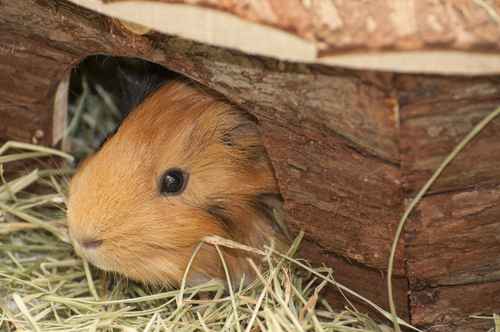
Being prey animals, guinea pigs are naturally cautious of those things that are new to them, such as unfamiliar smells, sights, and sounds. When they think that there is a threat, their initial reaction is to first freeze and then flee.
You need to keep your pet from escaping, especially when they become to fearful or are motivated to get out. The cage also has to keep other animals from getting in. Therefore, it has to be enclosed and you should be able to latch the door shut. Also, wood can be easily gnawed so it's better to use cages made of stainless steel, hard plastic, or wire.
The decision to place a cover or lid depends on your circumstances. If there are other animals in the house that might try to get to your guinea pig or scare them, or if there are small kids that are not old enough to touch without an adult, then, yes, it’s best to have a cover.
Otherwise, keeping the habitat open on top would be okay. This will allow you to freely interact with your pet at any time, touching and handling them, and making them used to your hands.
· Be free from safety hazards
When buying or making a cage for your piggy, make sure that it's free from hazards that could injure it.
o Materials
Cavies like to chew and gnaw so you need to make sure that the materials of your cage are sturdy enough and that they don’t contain anything that would be hazardous to them.
o Grid size or bar spaces
It’s important to note here is that not all grids or bars are safe. According to Guinea Lynx, the distance between the grids should not be more than 1 1/2 inches (3.6 cm) for adult cavies. Bigger grid sizes have caused some of piggies to get stuck, which cost them their lives. Some suggest 1-inch space between bars.
Also, if you have pups, line the grids with coroplast, cardboard, or plexiglass to keep them from putting their heads through the holes. You can also use mesh wires. Another suggestion is keeping baby piggies below 2 months in a cage with a deeper pan to prevent them from reaching the bars.
o Flooring
Many people think that by using grated flooring for the cage, they will have an easier time cleaning because poop would go through the spaces. However, using this material is highly discouraged because the guinea pigs’ tiny feet can inured.
Cavies have long claws that can get stuck if the cage has a wire mesh floor, so that has to be avoided or remedied by means of a cage mat. It's good to mention here that your cavy's claws need to trimmed regularly.
Also, the cavies’ miniscule feet have to bear the weight of their rounded bodies, and constantly standing on the wires can result to a condition called bumblefoot, in which their feet become infected and swollen.
The best flooring is a solid surface. You can line this with newspaper and put bedding to absorb urine and catch the droppings.
o Levels
Guinea pigs love to explore and many owners provide their pets with multi-layer cages. This is okay provided that there is enough safety measures to keep your cavy from falling off a ledge. With their rounded, heavy body, then can injure themselves if they slip from a height of even just 12 inches.
Protect upper levels with railings or walls. Make sure these are sturdy in case your cavy leans on it. Also, an elderly guinea won’t enjoy multiple levels much so it’s best to provide it with a flat cage.
o Ramps
If your cavy’s cage has an upper level, then you need to place a ramp for it go up. This needs to be wide enough and also protected by railings. The inclination angle should not be too steep. Also, the flooring has to be textured or ridged so your pet doesn’t slide down.
Also, make sure that there are no protruding wires that might cause injury.
· Have proper ventilation
Make sure that your pet is getting enough air. Glass enclosures keep air from circulating so you should consider cages made of other materials.
· Have the right temperature
Your guinea pig and its cage should be protected from extreme temperatures. Your pet could suffer from heat stroke if it is subjected to too much heat such as direct sunlight or if the cage is placed too near a radiator. On the other hand, it can get chilled if exposed to freezing weather.
When choosing a cage, it would be wise to also consider the following features:
· Bars
For metal cages, use ones that is rust-resistant, such as those that are powder-coated. PVC-coated are also fine since they are longer-lasting than the ones made of non-treated galvanized metal cages, although the finish might crack or wear in time.
Coroplast will last longer if you clean it regularly. If your piggy gnaws on it, then you may find the need to replace it at least once during its lifetime.
· Pans
A strong plastic pan would make it easier for you to clean and scrub the urine, which tends to turn white as they dry up. It’s good to use one that you can bleach without worry of cracking.
If you intend to use fabric bedding, then a shallow pan will do, but if you want to use loose bedding substrate, then a deep 3- to 6-inch pan is advised. This is because your pet will be digging and much of the shavings will end up outside the cage. If, despite the deep pan, the bedding still get scattered on your floor, then you can secure strips of plexiglass or coroplast at the bottom side of the cage.
· Accessibility
Because you will have to pick up your pet every once in a while, you should be able to reach for it, preferably with both hands. Therefore, make sure that the opening is large enough for you to do this. There are also cage designs that have an opening on both the side and top, which makes it convenient for you.
Being able to access different areas in the cage will also make it easy for you to rearrange toys or clean all sections.
One thing that you need to make certain is that you can secure the door properly. You wouldn’t want it popping open when your cavy leans on it.
· Portability for Moving Around or Travel
If you believe that you need to move your pet periodically, such as placing it outside during the day and bringing it indoors in the evening, then you can either have two enclosures or a cage that you can move around. For the latter, commercial cages are better than home-made semi-permanent structures.
If you travel a lot, then you may want to choose a cage that you can easily disassemble and re-assemble. There are some commercial cages that are collapsible that you can pack easily. You might also need a carrier for bringing your pet along.
2. Why does a guinea pig need so much space?

The bigger the space you give your guinea pig, the better. Apart from having ramps and other play furniture, your pet also has to have enough flat, unobstructed space to run on and play around in. With this, it can:
· Be its natural active self
Instead of being forced to be sedentary, your cavy can come out and run in its own time whenever it feels like it, instead of having to remain in the same small area where all it can do is sleep and eat. Remember that their body clocks are not the same as yours, and they may require activity when it is not convenient for you. By having enough space, they can exercise and play on their own without having to wait for you to become available.
· Socialize more positively
By providing your pet with enough space, it is better stimulated rather than bored. In short, it becomes happier. If you have more than one guinea pig, which is advisable considering they are social animals, they can play together and then retreat to their hiding places when they want to be alone.
· Stay in good health
Just like any other pet – and humans, too – a sedentary lifestyle, lack of exercise, and obesity can cause health problems. Some of the issues your pet might suffer from if it is forced to not move around and play are bladder infection, respiratory problems, heart disease, among others. With enough room to run, your pet will be in better health and there is also reduced risk of fecal impaction, a condition among those without proper exercise.
Your pet is not the only one who will enjoy the benefits of having a lot of room. You, too, will appreciate it because a bigger cage tends to be easier to clean than smaller ones. Also, if your pet is happy and healthy, it is more entertaining and less worrisome. You will also have less visits to the vet, thus less expense.
3. What kind of cage does a guinea pig need?
You can either choose an indoor or outdoor cage for your guinea pig, depending on the climate in your area as well as the weather. It would be good to keep it indoors if it’s too cold or too hot, or if there’s a storm. On a nice day, it would be happy to play and graze outdoors.
If you want to keep your guinea pigs outdoors, then you can provide them with a hutch. It should have a cover overhead but it does not need to have a floor – cavies would enjoy eating the grass. This means that you do not have to provide them with a food container if they can freely graze, although you should not forget to give them water.
The enclosure should not only keep your pet in but it should also keep predators out. The cage has to be fixed to the ground and the door should not be easily opened so dogs, foxes, cats, and other animals – especially smart ones – won’t be able to break in. Cavies don’t burrow but some predators might try, so make sure that there is no crawling space underneath the sides.
You can choose to use mesh wire for all four sides, but some owners opt to keep a portion walled with solid material. This way, the guinea pigs do not sense danger from that side and it would be where they can run if they sense a threat.
Moreover, you should provide your guinea pig with hiding places in case it feel threatened. You can provide it with some hidey-holes where it can keep out of sight, such as a homemade box with a small door. You can also be creative and use an old bucket or pot – cut away an opening and place it upside-down inside the hutch.
One nice design posted on Pinterest shows a cage made of wood and mesh wire, with the big door on the side. The bottom part of the sides is made of brick, and there are grass and plants inside.
There are many indoor cages available for purchase, and these come in a huge range of sizes, styles, color, and material. You can choose one based on you preference but you can also make one of your own. Either is fine as long as:
o There is enough room.
o There is good ventilation.
o You can hang a water dispenser.
o Your guinea pig cannot gnaw through the material.
o The material is not hazardous to your pet.
o You can conveniently clean it.
If you keep your pet indoors and there are no other animals in the house, then you can also opt for one without a cover, like the ones posted on
One reminder, however: many pet stores that sell cages and claim that they are good for guinea pigs. These are either made of plastic or metal grills. However, these are often too small, especially the starter sets, and even the big ones do not usually meet even the minimum size required. They can also be quite costly.
· Home-Made Cages
The best way to give your pet a suitable home where it can feel happy and remain healthy is to make one. Many guinea pig owners have come up with some really interesting ideas that you can base your project on.
Some people think that aquariums can be used to keep guinea pigs. This is not really advised because:
· There is not enough room
Unless you have a really large aquarium, your pet will not have the space it needs to play and exercise; more so if you have more than one cavy, which, as mentioned earlier, is better because of their social nature.
· It can be hard to clean
An aquarium, especially a big one, is heavy and deep so you may find it difficult to reach in and clean the inside thoroughly.
· There is not enough ventilation
Air doesn’t circulate well inside a glass case, so your pet might be breathing stagnant air or it may feel too hot without you realizing it.
· It may cause your guinea pig to be skittish
If you keep your pet an aquarium, it will not be used to the normal noises outside since sound is muffled by the glass. This may cause your pet to feel uneasy when you take it out.
4. How to make homemade guinea pig cages
If you are handy with construction tools, then you can easily build a fancy, stylish cage for your guinea pig. There are many do-it-yourself ideas over the Internet that you may find inspiration from, such as the ones posted on website Tierische Eigenheime and this one posted on Pinterest.
You can also use your creativity to repurpose some of your old stuff to make into a nifty guinea pig cage. For instance:
· Old shelf
Instead of putting your old bookshelf, TV shelf, dresser, or other used cabinets in the junk, you can make a nice home for your guinea pig such as this one from Guinea Pig Cages. Place protection underneath so the wood won’t get wet or dirty. Just make sure that you can open the front so you can clean it. More importantly, there should be proper ventilation.
· Storage containers
You can use large plastic storage containers and turn them into a guinea pig cage. This is suggested by the blog Hammy Happenings as a hamster home. For this, you need to cut out the sides and top of the container and replace them with mesh wire or used cage bars. Depending on your design, you can make several layers by putting one on top of the other and providing a way for your pet to move up and down.
· Old kiddie pool
One resourceful guinea pig owner made use of an old plastic pool and enclosed it with fence. This is a smart idea, although it would require ample floor space in your home and may require some effort to clean.
· C&C cages
Cubes and
C&C guinea pig cages are available online, such as at Guinea Pig Cages Store and Amazon.
If you are wondering where to buy Coroplast (a brand name of corrugated plastic) as a base for your guinea pig cage, there are those available in Guinea Pig Cages or elsewhere online. They are also available in sign or printing shops or home depots or stores that sell big boxes and corrugated plastic.
5. What to put in a guinea pig cage
Once you’ve acquired or built a spacious cage for your guinea pig, you need to put in the accessories. These include:
While you can provide your pet with a water dish, this has a tendency to get dirty. It is better to use a water bottle that you can hang. Make sure that this can easily be accessed and is placed at a comfortable height.
Unless your guinea pig is housed outdoors and has ample grass to eat, then you need to provide it with a food dish. This has to be one that it cannot chew and stable enough so it won’t topple over. It should also be big enough to put lots of pellets but not that big for it to get its whole body inside, so your pet won’t pee or poop into it.
Your pet should have place to hide in case it gets startled or it wants to be alone to rest. There are igloo-type nests that are being sold in pet supply stores, or you can just make one such as a wooden box with an opening.
· Toys
Your guinea pig will enjoy exploring through tunnels. You can use PVC pipes that are wide enough for it scamper through. You can also provide it with chew toys that are safe – avoid using plastics that can harm it if it swallows a piece. There are available wood toys and blocks that you can purchase.
· Hay rack
You also need to put a kind of manger in which you can place fresh hay and grass. This should be placed where it cannot get soiled. You can use a used plastic bottle, cut the top half, and carve a hole on the bottom side, such as this one posted on Pinterest.
· Bedding
And of course, you need to provide bedding for your piggy. Here are some options:
You can use Aspen wood shavings, since these are readily available from shops, safe for your pets, and are absorbent. Regular pine or cedar is not recommended because it can affect your pet’s health. I personal like wood shavings for it's easier to clean and getting them from a reputable brand simply gives me peace of mind.
o Recycled paper
You can also use recycled paper/wood products like Carefresh or cellulose fibers, which are gentler on the feet, especially for elderly cavies or those who have pains on their feet.
Both of the above bedding options are recommended because aside from absorbing urine and keeping the cage dry, droppings also tend to go down the pile, away from your pet. You can also use a combination of both. Make sure to provide enough so that it is at least 1.5 inches deep.
o Fleece
Some people may find that using fleece is cute and nice. There are many colors and designs available, which can make your pet’s cage attractive and fun to look at. It is safe for cavies and gentle on their feet, and liquids seep through if wicked properly. It can also cost-effective in the long-run since it’s reusable and washable – you do not have to keep on buying new bedding.
However, you need to be ready because of it’s high maintenance requirements. First, droppings remain on the surface, which means you need to brush or sweep it more often, once or more times a day. Second, it needs regular washing, and you need to do it thoroughly to avoid bacteria buildup as well as remove fur or hay. Third, it needs to be correctly prepared and, because liquids go through, a layer of absorbent material needs to placed underneath.
The cage liners that you can use include newspapers, mattress protectors, puppy training pads, towels, Uhaul pads, among others. There are also those available in stores that are designed specifically for use with fleece. It’s best to have third layer at the bottom – a waterproof fabric to prevent seepage into the cage.
6. Where to put your guinea pig cage
Whichever type of enclosure you choose, be it indoors or outdoors, you need to remember:
· Avoid damp or drafty environments
Your pet can get sick when their environment is wet or damp, or if there is too much moisture. Its health can also be affected by poor ventilation or a dirty living area.
· Protect your pet from extreme temperatures
Guinea pigs can suffer from heat stroke in temperatures above 26 degrees Celsius. Therefore, make sure that you provide sufficient shelter from direct sunlight if outdoors. Similarly, when indoors, keep the cage away from windows where the sun shines directly and do not put it beside radiators or heaters.
Cavies can also feel too cold in temperatures below 15 degrees Celsius, so provide proper bedding to keep them warm.
· Give both attention and alone time
When choosing a location for your pet cage, make sure that it is not beside your stereo, television, or anywhere noisy. You may want to put in the family room where your pet can have plenty of attention, but it should also have some alone time if it doesn’t feel like playing.
· Make your guinea pig feel safe and comfortable
Your pet may feel threatened or agitated in the presence of other animals. Extreme fear can be a cause of death, so it’s best to keep them away from pets like cats or ferrets. Put the cage where predatory animals cannot access it so as not to keep your guinea pig in constant fear.
7. How to make your guinea pig comfortable in its cage
When you bring home a new guinea pig or introduce it to a new enclosure, it will feel some discomfort or even fear. Therefore, you need to help it a bit. Here are ways you can do it:
· Provide for its needs
Make sure that before you place your guinea pig inside the cage, it already has bedding and that there is food and water inside. There should be that place where it can hide as well as some toys it can play with.
You might also want to initially use beddings and food that it is used to before slowly introducing new ones.
· Give it time
Making your piggy feel at home in its new cage requires time because it needs to become accustomed to its new surroundings. Cavies are naturally cautious so you should allow it to take its time to explore and feel secured.
· Avoid scaring it
Keep music low and make sure that your other pets, if you have any, are not in the vicinity. Excited kids who can’t wait to handle it might not be a good idea, either. It’s better to wait for a day or two, allowing it to get to know its surroundings first, before you start trying to introduce yourself.
You might even want to consider putting a light cloth over the cage initially so it can get to know its new surroundings without fear. Just make sure that this does not impede air circulation.
Even when you start handling your pet, don’t make the mistake of grabbing or cornering it just to catch it. It will become fearful of your hand. Instead, coax it and lure it out.
· Provide a friend
As mentioned earlier, cavies are social animals so you may want to have two or more piggies instead of one.
If, on the other hand, you are bringing home a cavy as a companion for one you already have, then it would be good idea to introduce them slowly. Keep your new guinea pig in a separate cage first until you’ve had it checked by a vet and after observing that it’s healthy and eating naturally.
After two weeks of quarantine, you can introduce your cavies slowly. Do not put them in the same cage at once because they might fight. Allow them to recognize each others’ scents first, then let them spend more and more time together.
Two males don’t normally get along.
· Let it recognize your voice and scent
Don’t just walk toward the cage and grab your pet or put food in. It will think that you’re a threat. Instead, talk to it gently and show your hand slowly. Put it about a foot from your piggy so it can see and smell it. This way, it will recognize that you’re not intending to harm it.
Another good idea is to have a regular schedule – when to pick it up, give treats, let it have floor time, and when to clean the cage.
8. Cage Cleaning Tips
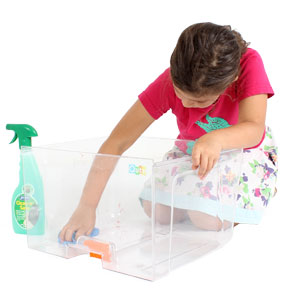
Guinea pig cages need to be cleaned regularly – before it begins to stink. In other words, you should not allow it to smell at all.
If you are using the right amount of loose bedding, then you will almost always find the bottom of the cage dry, making it easy to sweep and clean. If you find lots of wet spots, then you may want to add more bedding or replace the type that you use.
· When to clean a guinea pig cage
An outdoor hutch does not really need to be cleaned unless there is a little house in there with a solid floor.
An indoor cage needs more attention, but it’s not really that demanding. Some find that once a week of thorough cleaning is enough – that is, the bottom and sides are cleaned and the bedding are replaced – but others prefer to do it more often.
Between the days of thorough cleaning, you will need to do spot cleaning, meaning you need to clean those areas that are particularly dirty or wet. Some find twice a week is enough, but others prefer to do it daily.
· What to use when cleaning your cavy’s cage
Depending on your pet’s cage, you would need materials to clean it. For semi-permanent structures or those you cannot carry outside, you would need to have a broom and dustpan as well as garbage can lined with the appropriate garbage bag. You also need a sprayer, water, and cleaning solution.
For cages that you can bring outside or trays that you can take out, you’d need a broom and dustpan, a garbage can lined with a garbage bag, cleaning solution, and a water hose.
For solutions, you can use white vinegar. Since urine is alkaline, the acid in vinegar can neutralize the urine buildup, making it easy to clean. A solution composed of 50 percent vinegar and 50 percent water is usually enough, but you can use full strength (or 5 percent solution) to get rid of stubborn stains.
If you prefer to use bleach, mix a solution of 10 percent bleach and 90 percent water.
Make sure to check the laws about animal waste in your area. Some local governments don’t allow throwing these along with other garbage. If you are using natural bedding, then you may want to add it in your compost heap.
· How to clean your little piggy’s cage
After you take out your pet, you can sweep and scoop the bedding. Make sure to take away every bit, all the way to the corners. Spray the cage with your vinegar solution then wipe dry. Once dry, you can put fresh bedding and let your pet inside. If you use bleach, then you need to rinse it thoroughly.
Another way of cleaning the cage is to bring it outside, scrape off the bedding and droppings, and hose it down. You can scrub it with your cleaning solution and rinse it thoroughly, then let dry. Once dry, you can bring it back inside, replace the bedding with fresh ones, then put your pet back in.
As no one wants to spend their whole life in a really small space without any room to have fun, so would your guinea pig. Provide your pet with the right habitat and care, and you will reap the rewards of keeping a happy cavy.

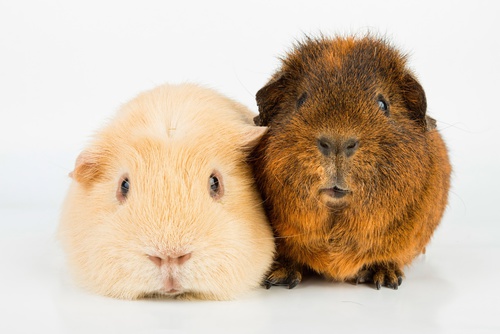







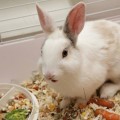
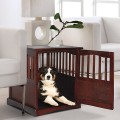

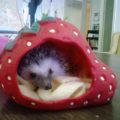


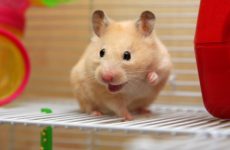



One Comment